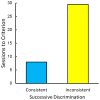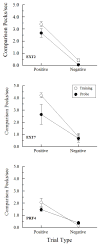Associative concept learning in animals
- PMID: 24170540
- PMCID: PMC3927728
- DOI: 10.1002/jeab.55
Associative concept learning in animals
Abstract
Nonhuman animals show evidence for three types of concept learning: perceptual or similarity-based in which objects/stimuli are categorized based on physical similarity; relational in which one object/stimulus is categorized relative to another (e.g., same/different); and associative in which arbitrary stimuli become interchangeable with one another by virtue of a common association with another stimulus, outcome, or response. In this article, we focus on various methods for establishing associative concepts in nonhuman animals and evaluate data documenting the development of associative classes of stimuli. We also examine the nature of the common within-class representation of samples that have been associated with the same reinforced comparison response (i.e., many-to-one matching) by describing manipulations for distinguishing possible representations. Associative concepts provide one foundation for human language such that spoken and written words and the objects they represent become members of a class of interchangeable stimuli. The mechanisms of associative concept learning and the behavioral flexibility it allows, however, are also evident in the adaptive behaviors of animals lacking language.
Keywords: associative concepts; equivalence; many-to-one matching; within-class representation.
© Society for the Experimental Analysis of Behavior.
Figures






Comment in
-
Meaning is more than associations: relational operants and the search for derived relations in nonhumans.J Exp Anal Behav. 2014 Jan;101(1):152-5. doi: 10.1002/jeab.57. Epub 2013 Nov 19. J Exp Anal Behav. 2014. PMID: 24249646 No abstract available.
-
"Associative concept learning in animals" by Zentall, Wasserman, and Urcuioli: a commentary.J Exp Anal Behav. 2014 Jan;101(1):161-4. doi: 10.1002/jeab.59. Epub 2013 Nov 19. J Exp Anal Behav. 2014. PMID: 24249692 No abstract available.
-
Associative concept learning, stimulus equivalence, and relational frame theory: working out the similarities and differences between human and nonhuman behavior.J Exp Anal Behav. 2014 Jan;101(1):156-60. doi: 10.1002/jeab.60. Epub 2013 Nov 19. J Exp Anal Behav. 2014. PMID: 24249703 No abstract available.
References
-
- Alling K, Nickel M, Poling A. The effects of differential and nondifferential outcomes on response rates and accuracy under a delayed-matching-to-sample procedure. The Psychological Record. 1991;41:537–549.
-
- Asch SE, Ebenholtz SM. The principle of associative symmetry. Proceedings of the American Philosophical Society. 1962;106:135–163.
-
- Astley SL, Peissig JJ, Wasserman EA. Superordinate categorization via learned stimulus equivalence: Quantity of reinforcement, hedonic value, and the nature of the mediator. Journal of Experimental Psychology: Animal Behavior Processes. 2001;27:252–268. - PubMed
-
- Astley SL, Wasserman EA. Novelty and functional equivalence in superordinate categorization by pigeons. Animal Learning & Behavior. 1998;26:125–138.
-
- Astley SL, Wasserman EA. Superordinate category formation in pigeons: Association with a common delay or probability of food reinforcement makes perceptually dissimilar stimuli functionally equivalent. Journal of Experimental Psychology: Animal Behavior Processes. 1999;25:415–432. - PubMed
Publication types
MeSH terms
Grants and funding
LinkOut - more resources
Full Text Sources
Other Literature Sources

